When retailers ask me why their remarketing/retargeting efforts are failing, I always default to my choice for the number one mistake that even experienced advertisers make: improper or lack of segmentation.
I have found that the proper use of segmentation lays down the ideal framework for one to effectively manage, optimize, and analyze remarketing campaigns and especially those under the umbrella of Google AdWords.
While it can take substantial time and effort, there is no substitute for a strong segmentation strategy and how it can help one increase the effectiveness and conversion potential of one’s Remarketing initiatives.
Not too long ago, Google released a new form of Remarketing known as RLSA or Remarketing Lists for Search Ads. While not technically a “campaign,” RLSA itself is a unique form of audience retargeting also available to ecommerce business owners using Google Shopping.
RLSA itself is literally Segmentation at its best and, when properly managed, can contribute to more conversions at an often substantially lower cost-to-convert.
Before We Go Too Far
What is Remarketing/Retargeting?
As it relates to massive networks such as the Google Display Network (GDN for short), remarketing typically refers an advertising campaign which targets previous visitors to one’s website and displays advertiser-defined ads. This almost always requires the implementation of certain javascript code on one’s website which collects cookie data to build an audience of previous visitors. Ads will then “follow” visitors around to web and are displayed on other, non-Google web properties.
RLSA specifically allows for the use of either AdWords-defined or Google Analytics-built audiences which can be added to campaigns without the need for the creation of an additional campaign and application of a dedicated budget. With RLSA, ads are displayed right back in Google’s search instead of following previous site visitors around the internet on other websites.
What is Segmentation?
Specific to digital marketing, segmentation refers to the practice of analyzing one’s website/online store visitors and splitting them into unique groups or “segments.” It is with these segments that advertisers and/or retailers may deliver more targeted, personalized messages or ads to previous visitors in their remarketing efforts.
With RLSA, the shopping ads served to previous visitors will match up to that which was already viewed on a website. The aspect of “personalization” is automated which solves for a major piece in the puzzle of segmentation. It is, however, imperative that one takes the right approach to managing and understanding each unique segment.
With That Being Said
Now that we have covered the basics, it is time to get into the real meat of it all. I will be covering:
The Difference Between AdWords & Analytics Remarketing The Top 5 RLSA Segments for Online Retailers Using Google Shopping How to Set Up RLSA Audiences Via Google AnalyticsWith this, we hope that if you aren’t already Remarketing, then it will fuel you to get started. For those who have existing Remarketing efforts then maybe it is time to take a deeper dive into their setup and performance analyses.
Remarketing: Google AdWords VS Google Analytics
Both AdWords and Analytics are what are referred to as “tag-based” implementations wherein each provides a unique snippet of code which can then be added to one’s website (typically on every page). This can be done with great ease with Google Tag Manager.
Once added, the snippet of code tracks any visitor’s session, captures its cookie, and feeds that information back to its respective host platform.
The two most significant differences between the two are set up and customization.
AdWords: When creating a Remarketing campaign for the first time, AdWords will generate a tag for you which then needs to be implemented. Your first audience will be your ‘All visitors’ which collects every person who visits your site as long as the Remarketing tag is on a page they visited. AdWords will also be able to automatically build additional audiences based on your campaign or performance history. For example, AdWords may automatically generate a new audience called ‘All converters.’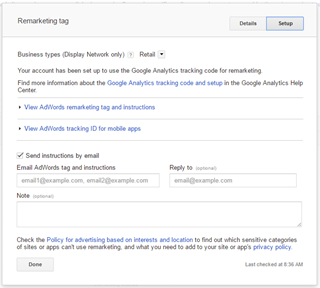
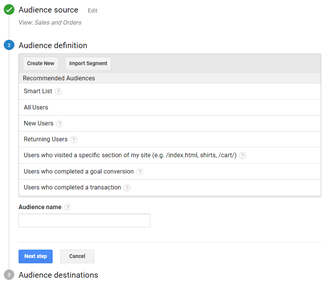
While AdWords-based remarketing is excellent in its own right, we highly recommend taking advantage of the customization within Google Analytics especially if you are an ecommerce business owner.
The Top 5 RLSA Segments
As unique as you can get with Analytics-based audiences, following routine best practices as an online retailer often bares the sweetest fruit.
For any retailer that we work with, our team applies these best practices in the development of audiences and the bidding optimization.
It all starts with the implementation of 5 strategic audiences which can all be built in Google Analytics.
All Visitors: A standard for just about any Remarketing campaign, the All Visitors segment can be built using either AdWords (probably the easiest way since it is automatic) or Analytics. High Bounce Rate: What is really nice about Analytics audiences is that you can customize based on data which cannot be found in AdWords. With that, the setup and delivery to visitors with higher than average bounce rates for ecommerce websites (over 80% and up to 95%) is a prime target. View Cart: Analytics allows for the use of logic in building audiences where you can combine ‘include and exclude’ parameters. A View Cart audience would be anyone that viewed the cart page but not the checkout page. Abandoned Cart: A slight variation to ‘View Cart,’ Abandoned Cart audiences refer to shoppers you visited the checkout page but don’t finalize a purchase. All Converters: One that can work in both AdWords and Analytics, targeting anyone who has already purchased is never a bad idea. Often you can increase return sales at a lower cost to convert than the base cost-per-acquisition from a Shopping or Search campaign.Per each audience, a unique bid modification strategy needs to be implemented, and this is generally handled through Bid Modifiers in AdWords.
A slight form of automation, Bid Modifiers allow one to set a percentage increase or decrease to RLSA audiences.
Bid Modifiers exist elsewhere too. One of the most common use cases for Bid Modifiers is for Device Segmentation. Columnist and segmentation advocate Aaron Levy outlines a number of the pros and cons to this specific side of AdWords segmentation in his post to Search Engine Land.
When it comes to bid modifiers in RLSA, the approach to any given audience should be based purely on visitor or shopper intent. You would necessarily bid or adjust bids the same for an ‘All visitors’ segment versus an ‘All converters’ segment.
It is a matter of balancing bid increases and bid reductions. We covered bid modifier strategies per some of these audiences in more detail.
How to Set Up Audiences: Google Analytics
So now that you have gotten a taste of what RLSA and Segmentation are all about, let’s dive into what it takes to actually set up an audience in Google Analytics.
Here is a quick, step-by-step guide:
Pro Tip: Note that you will need to connect Google AdWords with Google Analytics to allow for data collection to pass between both. Ecommerce retailers should also be taking advantage of Analytics-based Conversion Tracking.
The following occurs in the Admin section of your Google Analytics account. If you have yet to do so, please go ahead and turn on Remarketing data collection by:
Selecting ‘Tracking Info’ in the Property column Click on ‘Data Collection’ Toggle the ‘Remarketing’ option from OFF to ON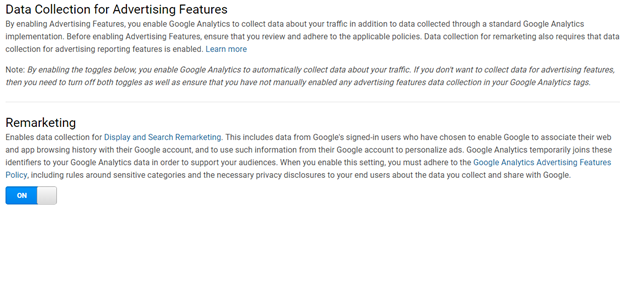
From the Property column again, scroll down to find and click on ‘Audience Definitions:’
Click on ‘Audiences’. Click on ‘+NEW AUDIENCE’ (red button). Analytics will provide some suggested audiences or you can choose to ‘Create New’. The ‘Audience Builder’ will pop up where you can define conditions for any segment. See below for an example of the ‘Abandoned Cart’ audience.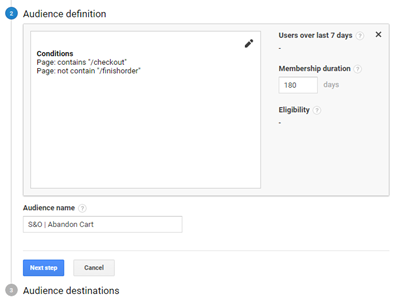
Building this particular audience is relatively simple. From the Audience Builder, you would select ‘Conditions’ under the Advanced options.
Set the filter to ‘Page’. Apply logic for both contains and not contain.Now you might be wondering about Membership duration. This essentially sets a time frame for which a unique individual may belong to the segment. For most ecommerce businesses, setting this to a substantial duration such as 180 days is a best practice.
The longer a previous visitor belongs to an audience segment, the higher the probability of them seeing your retargeted ad which could lead to a return purchase.
Once you have defined your filter criteria, you can click on ‘Apply’ to complete the audience set up.
As long as you had connected Analytics with Google AdWords, you can choose the Audience destination for your AdWords account/CID.
By clicking Publish, your newly created segment will be ported to AdWords. Any audience you create can be found in the Shared Library > Audiences section of Google AdWords.
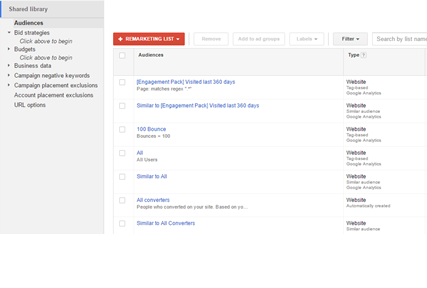
With your audience(s) now stored in AdWords, you can apply RLSA to either the campaign or ad group level from the AdWords interface.
Use the Bid adjustment column to apply bid modifiers to any of your audiences. RLSA will deliver the ads existent within the associated campaign/ad group to previous visitors right back in Google Search.
This includes previously viewed Products in your Ecommerce store in the form of retargeted Google Shopping ads.
Now It Is Your Turn
In a 2016 analysis of over 26,000 individual RLSA audiences we manage, it was found that (using the very same strategies we covered thus far) these optimized audience segments converted at a near 45% rate.
That is well beyond the industry-accepted across the board average AdWords conversion rate of only 2%.
With Google Shopping already being one if not the highest ROAS paid advertising channels for online retailers, adding RLSA into the mix is a no-brainer.
Put simply: If you aren’t applying Segmentation tactics and RLSA, you are missing out on more conversions and higher revenue.
As complex as AdWords, Google Shopping, and RLSA may be, we hope that we have influenced you enough to take a stab at developing your own Segmentation strategy.
The concept we have covered here can be applied far beyond the confines of AdWords, and you should consider integrating segmentation into other facets of your marketing such as Social PPC, Content Marketing, and Email Marketing.
Innovative SEO services
SEO is a patience game; no secret there. We`ll work with you to develop a Search strategy focused on producing increased traffic rankings in as early as 3-months.
A proven Allinclusive. SEO services for measuring, executing, and optimizing for Search Engine success. We say what we do and do what we say.
Our company as Semrush Agency Partner has designed a search engine optimization service that is both ethical and result-driven. We use the latest tools, strategies, and trends to help you move up in the search engines for the right keywords to get noticed by the right audience.
Today, you can schedule a Discovery call with us about your company needs.
Source:





